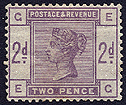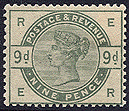The Green & Lilac Issue
1883-84
Great Britain was concerned about counterfeiting
and attempts to re-use stamps from the very onset. The change from
the Penny Black to the Penny Red, the use of the crown watermark
and the change from two to four check letters was all done to foil counterfeiting
and re-use of the
stamps. In addition to these cautionary
measures the government also wanted to issue stamps in doubly fugitive
ink. Unfortunately, De La
Rue could provide only to colors of doubly fugitive
ink: green and lilac. The use of doubly fugitive ink has resulted
in a vast supply of grossly
inferior copies of these stamps. The stamps
have been soaked off paper by collectors and in most cases the ink has
been badly damaged rendering the stamps valueless. Considering the
cost of purchasing these stamps one should take great caution in making
sure that they are
buying copies without ink that has been damaged
by soaking. Looking closely at the design, it is not to difficult
to note whether the design has
been effected by the ink defusing or bleeding.
The copies shown below are pretty close to the proper shade of unaffected
green and lilac.
These stamps proved to be very unpopular with
both the postal employees and the public. Postal employees had trouble
distinguishing
the values due to the similar colors and designs.
The public simply thought the stamps were ugly.
Main
Contents Surface
Printed Introduction
















